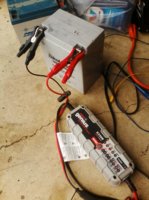ANLAF
XS650 Guru
fellers
Recently my 6 months old battery fried. Now holds a steady charge of 10.80 v,olts, so that indicates one of the cells is shot. Goodbye battery. Its under guarantee, so i will pick up a replacement. I checked the regulator/rectifier. Multimeter says all is good, diodes open one way only on each wire (0 one way and allowing 6.30 the other).
In the meantime I wired in my Sparx capacitor and have been running battery-less - and went on a 575 mile trip last weekend.
I want to make sure I am not missing anything here.
Something fried the battery. It wasn't the reg/rec, so I can only think it was a duff unit. The capacitor and reg/rec combo seems to be working just fine.
Has anyone anyone warning lights to flash at me.
By the way, I looked after the battery the short time we were together, trickle-charger, and so on, so I am trying to understand why the acid in the cells went down - cell one under the positive connection was 3/4 gone, and it stepped up then to cell six..
That's just weird. I topped up with ionised distilled water, but I was too late.
Any suggestions as to why these things happen would be gratefully received.
ANLAF
Recently my 6 months old battery fried. Now holds a steady charge of 10.80 v,olts, so that indicates one of the cells is shot. Goodbye battery. Its under guarantee, so i will pick up a replacement. I checked the regulator/rectifier. Multimeter says all is good, diodes open one way only on each wire (0 one way and allowing 6.30 the other).
In the meantime I wired in my Sparx capacitor and have been running battery-less - and went on a 575 mile trip last weekend.
I want to make sure I am not missing anything here.
Something fried the battery. It wasn't the reg/rec, so I can only think it was a duff unit. The capacitor and reg/rec combo seems to be working just fine.
Has anyone anyone warning lights to flash at me.
By the way, I looked after the battery the short time we were together, trickle-charger, and so on, so I am trying to understand why the acid in the cells went down - cell one under the positive connection was 3/4 gone, and it stepped up then to cell six..
That's just weird. I topped up with ionised distilled water, but I was too late.
Any suggestions as to why these things happen would be gratefully received.
ANLAF



